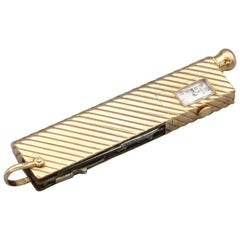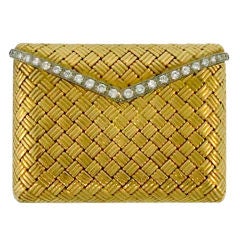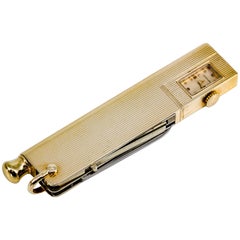Verdura Clock
Vintage 1940s More Jewelry
14k Gold
Recent Sales
American Jewelry
Vintage 1940s More Jewelry
14k Gold
Vintage 1980s French Enamel Frames and Objects
Brass
People Also Browsed
Vintage 1970s French Modernist Band Rings
Coral, Diamond, White Diamond, 18k Gold, Yellow Gold
Early 2000s Italian Evening Dresses and Gowns
Vintage 1920s American Art Deco Wrist Watches
Diamond, White Diamond, Platinum
20th Century Band Rings
Diamond, Emerald, Ruby, Sapphire, 18k Gold
Early 20th Century European Late Victorian Pendant Necklaces
Gold, 9k Gold
21st Century and Contemporary Swiss Wrist Watches
Diamond, 18k Gold, White Gold
21st Century and Contemporary Wrist Watches
Diamond, Emerald, Gold, 18k Gold, Yellow Gold
Vintage 1950s French Retro Signet Rings
Lapis Lazuli, Gold, 18k Gold, Yellow Gold
Antique 17th Century Unknown Band Rings
Yellow Gold
Vintage 1910s Unknown Edwardian Pocket Watches
Pearl, 18k Gold, Platinum, Enamel
Vintage 1910s Edwardian Cufflinks
Diamond, Yellow Gold, Platinum, Enamel
Verdura for sale on 1stDibs
Fulco di Verdura (1898–1978) is not exactly a household name, except for those who know a thing or two about highly original, often eccentric handcrafted earrings and bracelets, and, even more so, for those fortunate enough to own some. In that exclusive group, Verdura is regarded as the most gifted and coveted designer of his time.
Verdura was born in Sicily in 1898, the scion of a noble family related to the Lampedusas. (His cousin, Giuseppe di Lampedusa, wrote the great Italian saga The Leopard). His life was charmed from birth. Raised in his family’s villa, he grew up during a time when Sicily, and Palermo in particular, were meccas for well-born and highly cultured European travelers.
A bona fide duke with no clear ambitions but creative leanings aplenty (he could draw and paint), the young Verdura was part of the wandering social circuit — the so-called beau monde — that went from capital to capital, resort to resort.
Verdura, though small in stature, had that indefinable quality called charm. As a result, he was the life of every party he attended. When he finally started designing jewelry under Coco Chanel in the late 1920s, many of his friends became his clients (or received the pieces as gifts).
Elsa Maxwell took him under her ample wing when she was hired to do public relations for the Lido in Venice and introduced him to the local and visiting cognoscenti. Chanel, whom he met in Venice, hired him to work in the textiles division of her fashion house. But it was his flair for jewelry that soon caught Coco’s eye. Eventually, he rose to become her personal designer of fine jewelry.
In 2002’s Verdura: The Life and Work of a Master Jeweler (Thames & Hudson), Vanity Fair’s Amy Fine Collins describes the sensation of wearing pieces by Verdura, who drew inspiration from nature for his signature gem-studded seashell brooches and honeybee earrings.
“They were ingeniously calculated to flatter the wearer,” writes Collins. “Earrings undulated to complement the convolutions of an earlobe, rings seductively followed the phalanges of a finger, and necklaces gracefully traced the anatomy of the throat.”
In 1934, Verdura left Chanel and together with two friends, aspiring actress Princess Natalia Pavlovna Paley and Baron Nicholas de Gunzburg, moved to the U.S. After several stops, he found a job through Diana Vreeland in Hollywood with Paul Flato, then the “jeweler to the stars.” Soon he was signing his work and helping Flato cultivate the crème de la creme of the silver screen — those both on it and behind it.
Verdura left Los Angeles for New York and opened his own salon, first on Fifth Avenue in 1939, just as World War II was beginning in Europe. His backers were Vincent Astor and Cole Porter, for whom he made bejeweled boxes and cigarette cases — gifts from Porter’s wife, Linda — to commemorate the opening nights of several musicals.
Verdura began to expand both his repertoire — he became much more daring and flamboyant — and his clientele. The Duchess of Windsor, Daisy Fellowes, Greta Garbo and others routinely gave him commissions. In 1941, Verdura collaborated on a collection of six pieces with Salvador Dalí to accompany a Dalí exhibition at the Museum of Modern Art. Verdura retired in 1972 and left the care of the company to his partner, Joseph Alfano. He later moved to London, where he died in 1978 at the age of 79.
Among the most prized pieces on display in a 2014 Verdura jewelry exhibition in New York were Greta Garbo’s curb-link bracelet watch, which Verdura designed for her in 1939; Coco Chanel’s pair of Maltese Cross cuff bracelets (she wore one on each wrist); and Diana Vreeland’s duo of Byzantine brooches.
Find a range of vintage Verdura jewelry today on 1stDibs.


